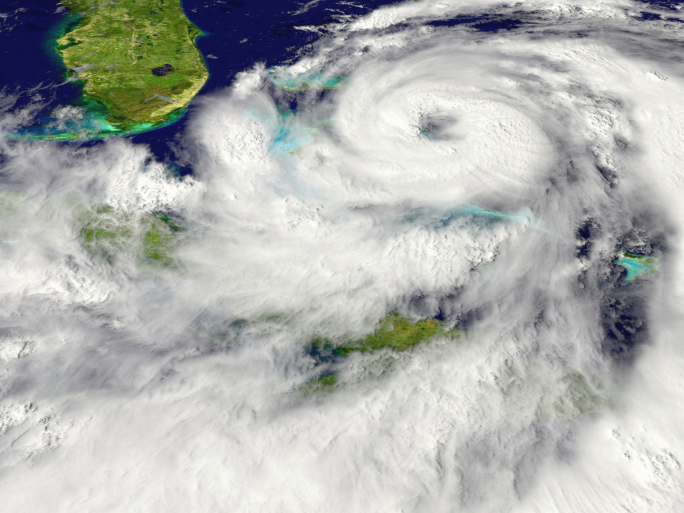 Images of death and destruction are easily conjured within our minds when hearing the word "Hurricane!"
Images of death and destruction are easily conjured within our minds when hearing the word "Hurricane!"
Due to his or her vulnerability, the mariner's images are even more vivid and threatening. This is probably true due to the fact that hurricane conditions have a tremendous effect upon the ocean. The ocean is no place for the recreational boater to be during the extreme conditions associated with a hurricane.
Hurricane season runs from June 1st through November 30th of each year. This is no time to drop our guard. I'd like to start by reviewing some of the hurricane-associated terminology, and then discuss some specific preparations that mariners can take to help themselves and their boats survive the storm.
A hurricane watch is issued by the National Weather Service when a hurricane may threaten a specified portion of the coast. It is issued 36 hours before landfall may occur. A hurricane warning is issued when hurricane conditions are expected for a specified portion of the coast within 24 hours of landfall.
There are five categories of hurricanes
- Category (1): winds 74 to 95 MPH - 4 to 5 foot storm surge
- Category (2): winds 96 to 110 MPH - 6 to 8 foot storm surge
- Category (3): winds 111 to 130 MPH - 9 to 12 foot storm surge
- Category (4): winds 131 to 155 MPH - 13 to 18 foot storm surge
- Category (5): winds 156 MPH and above - 18 foot and above storm surge
Despite the fact that we are more then half way through this year's hurricane season, we must continue to maintain our vigilance and forehandedness. It makes good sense to have a hurricane plan in place long before a hurricane is bearing down on us. When formulating our hurricane plans we must always keep in mind that "life always comes before property." I strongly encourage that you heed all evacuation notices issued by your local county emergency management office regardless of the vulnerability of your boat.
Mariners are faced with a significant challenge when formulating an effective plan to protect their most cherished property. We must keep in mind that, despite their best preparatory efforts, many mariners still have lost their boats to the ravaging effects of these storms. A non-trailerable boat at a coastal mooring is in a very vulnerable spot. This fact should not deter us from completing some common sense preparations.
It would be wise to have your boat properly secured long before any public evacuation notices are issued. Waiting too long to make preparations may trap your boat at its present location, or worse, result in you being in a dangerous location during the storm. Note that the draw bridges are authorized to remain closed upon the approach of gale force winds of 34 knots or greater. Make preparations early and then evacuate to safe location.
Due to the various levels of their intensity and the unpredictability of a hurricane's track, I have found it very effective when formulating a hurricane plan to list all the possible options. Then, upon a hurricane's approach, chose the options that best fit the particular circumstances.
For example, if you own a trailerable boat, what would be some of the possible options to take in an effort to save your boat? You may want to tow the boat to a safe location outside of the path of the storm. Another option might be to keep your trailerable boat in your backyard, and with the manufacturer's approval, fill the hull with water. In addition, it may be a good idea to put your anchor out right there in your backyard. If the storm surge reaches your property the anchor may help the boat stay in your backyard. Keep in mind, these backyard actions may stop your boat from being blown around, but it will not protect it from falling trees and flying debris.
If it is a non-trailerable boat that you own, your best option may be to cruise to another part of the world during the Atlantic Hurricane season; the Great Lakes may be one option. Of course, this is not a viable option for most mariners. Some of the more common options may be to have one of the local marine dealers haul your boat out of the water and place it in protective dry storage upon the approach of a hurricane, or you may want to relocate your boat to a previously identified hurricane haven, or you may wish to reinforce your boat's present moorings and put out extra mooring lines. The publication "Hurricane Havens Handbook for the Atlantic Ocean" (stock # ADA 116103.) can be ordered from the National Technical information Service, 5285 Port Royal Road, Springfield, Va. 22161 (703) 487-4600.
I do not recommend that you get underway on your recreational vessel and head out to sea upon the approach of a hurricane to "ride out the storm." Most boats are not designed to withstand the large seas and high winds generated by these severe storms. It is most important for all mariners to obtain a daily updated tropical weather forecast and plan their boating activities accordingly. Keep abreast of what is happening just over the horizon in our earth's atmosphere.
Mariners are reminded that aids to navigation, particularly lighted and unlighted buoys, may be moved from charted position, damaged, destroyed, extinguished or otherwise deemed discrepant due to the effects of hurricanes and storms. Mariners should not rely solely upon the position or operation of an aid to navigation, but should also employ such other methods of determining position as may be available.
For more information about Florida boat insurance, give Casey Insurance Group a call at 888-537-1412 today!
(Source:boatsafe.com)